|
|
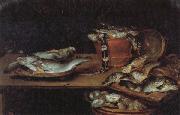 |
Alexander Adriaenssen
|
|
Flemish Baroque Era Painter, 1587-1661
Flemish painter. He was the son of the composer Emanuel Adriaenssen and brother to the painters Vincent Adriaenssen (1595-1675) and Niclaes Adriaenssen (1598-1648/9). In 1597 he was apprenticed to Artus van Laeck (d 1616) and in 1610 became a master in the painters' guild. In 1632 he took on Philips Milcx as apprentice, and in 1635 he painted the coats of arms of the 17 provinces on the triumphal arches in honour of the new governor. Adriaenssen's many signed and often dated oil paintings on wood and canvas are all still-lifes, mainly of food on tables with copper- and tinware, glass and pottery (e.g. Still-life with Fish, 1660; Amsterdam, Rijksmus.). There are four paintings of vases of flowers, but vases of flowers, as well as single flowers on the table, also appear in other still-life combinations. Only two canvases are known in which he worked with figure painters: a garland of flowers around a painting of the Holy Family (Ghent, Paul Boterdaele priv. col.) by Simon de Vos and a porcelain bowl of fruit beside a Virgin and Child (ex-Gal. 'Den Tijd', Antwerp, 1982) attributed to a follower of Rubens. His compositions are graceful and balanced but somewhat stereotyped, and they are bathed in a soft chiaroscuro. |
|
|
|
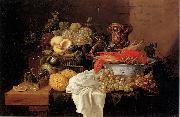 |
Alexander Coosemans
|
|
(1627, Antwerp - 1689, Antwerp), was a Flemish Baroque painter.
According to the RKD he was registered as a pupil of Jan Davidsz de Heem in 1641 and in 1645 he became a master in the Guild of St. Luke.He travelled to Rome in 1649 but was back in Antwerp in 1651. He painted flowers, fruit, and inanimate subjects, and flourished in the Netherlands about 1630. Fruit subjects by him are in the Augsburg Gallery and the Belvedere at Vienna. In the Madrid Gallery there is a fruit-piece attributed to a J. D. Cooseman, who is said to have flourished in the Netherlands in the 17th century: and in the Bordeaux Museum, a fruit-piece ascribed to a N. Coosman. He was followed by Hendrik Schoock. |
|
|
|
|
|
 |
Alexander Helwig Wyant
|
|
American Tonalist Painter, 1836-1892,American painter. He began as an itinerant painter of topographical landscapes along the banks of the Ohio River c. 1854, influenced by such landscape artists as Worthington Whittredge and George Inness. In 1863-4 Wyant moved to New York, where he was impressed by the paintings of the Norwegian artist Hans Gude in the Desseldorf Gallery. This led him to work with Gude in Karlsruhe, Germany, in 1865. On his way both there and back, he studied paintings by Constable and used a more painterly technique especially for views of Ireland. |
|
|
|
|
|
 |
Alexander Ivanov
|
|
1806-1858
Russian Alexander Ivanov Galleries
was a Russian painter who adhered to the waning tradition of Neoclassicism but found little sympathy with his contemporaries.
Ivanov studied together with Karl Briullov at the Imperial Academy of Arts under his father, Andrey A. Ivanov. He spent most of his life in Rome where he befriended Gogol and succumbed to the influence of the Nazarenes. He has been called the master of one work, for it took 20 years to complete his magnum opus, The Appearance of Christ before the People (1837-57).
It was for the next generation of art critics to do him justice. Some of the numerous sketches he had prepared for The Appearance have been recognized as masterpieces in their own right. Although Ivanov's major painting is a gem of the Tretyakov Gallery, the most comprehensive collection of his works can be viewed at the Russian Museum in St Petersburg. |
|
|
|
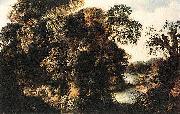 |
Alexander Keirincx
|
|
Alexander Keirincx (Antwerp, 23 January 1600-Amsterdam, 1652) was a Flemish Baroque painter who spent his later career in the Dutch Republic. He became a master in Antwerp's guild of St. Luke in 1619, and like his teacher Abraham Govaerts he initially specialized in small cabinet-sized forest landscapes in the manner of Jan Brueghel the Elder and Gillis van Coninxloo. Also like Govaerts, Keirincx's early works typically show diminutive history, mythological or biblical subjects within a Mannerist three-color universal landscape bracketed by repoussoir trees. However, during the 1620s his landscapes become increasingly natural. He lived in Utrecht and Amsterdam from 1628 until the end of his career, and made trips to England to decorate palaces for Charles I. The figures in his works were usually painted by collaborators such as Cornelis Poelenburg.[1] Keirincx worked primarily as an art dealer later in life. |
|
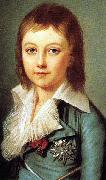 |
Alexander Kucharsky
|
|
Alexander Kucharsky (18 March 1741 - 5 November 1819) also Alexandre Kucharsky, was a Polish portrait painter who spent his adult life in France. He himself used the spelling Kucharsky, but Kucharski is also often used. In the past, in France, the name has been given as Couaski. |
|
|
|
 |
Alexander Mann
|
|
Alexander Mann (January 22, 1853 - January 26, 1908) was a Scottish landscape and genre painter. He was a member of New English Art Club and Royal Institute of Oil Painters.
Alexander Mann was born in Glasgow, Scotland on January 22, 1853. He died in London on January 26, 1908.
The second son of James Mann, merchant and collector, he took drawing lessons from the age of ten with Robert Greenlees (1820-94) and then attended evening classes at the Glasgow School of Art, where Greenlees was headmaster.
In 1877 he went to Paris and enrolled at the Academie Julian, and then studied under Mihely Munk? - sy and from 1881 to 1885 under Carolus-Duran. From 1883-93 Mann exhibited in London at the Royal Academy, Royal Institute of Oil Painters, Fine Art Society, New Gallery, Ridley Art Club, New English Art Club and Society of British Artists, a society that appointed James McNeill Whistler its President in 1886. At the same year he was invited to become the first Scottish member of the New English Art Club and was joined by several of his friends, notably John Lavery, Thomas Millie Dow of the Glasgow Boys and Norman Garstin.
Influenced by the Hague school and by Jules Bastien-Lepage, his picture A Bead Stringer, Venice gained an honorable mention at the Salon in 1885. After a public controversy over this painting when it was exhibited at the Royal Glasgow Institute, Mann settled in England, at West Hagbourne, Berkshire, and later in the neighboring village of Blewbury, where he painted a series of views of the Downs and portraits of country people. Mann traveled extensively in Britain, paying several visits to the coast in Angus and Fife, and to Walberswick, Suffolk. |
|
|
|
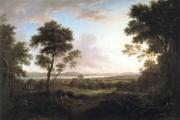 |
Alexander Nasmyth
|
|
Scottish Painter,
1758-1840
was a Scottish portrait and landscape painter, often called the father of Scottish landscape painting". Edinburgh Castle and Nor'Loch, circa 1780.Born in Edinburgh, he studied at the Royal High School and the Trustees Academy under Alexander Runciman, and, having been apprenticed as an heraldic painter to a coachbuilder, he, at the age of sixteen, attracted the attention of Allan Ramsay, who took the youth with him to London, and employed him upon the subordinate portions of his works. Nasmyth returned to Edinburgh in 1778, and was soon largely patronized as a portrait painter. He also assisted Mr Miller of Dalswinton, as draughtsman, in his mechanical researches and experiments; and, this gentleman having generously offered the painter a loan to enable him to pursue his studies abroad, he left in 1782 for Italy, where he remained two years. Robert Burns, 1787.On his return he painted the excellent portrait of Robert Burns, now in the Scottish National Gallery, well known through Walker's engraving. Political feeling at that time ran high in Edinburgh, and Nasmyth's pronounced Liberal opinions, which he was too outspoken and sincere to disguise, gave offence to many of his aristocratic patrons, and led to the diminution of his practice as a portraitist. In his later years, accordingly, he devoted himself mainly to landscape work, and did not disdain on occasion to set his hand to scene-painting for the theatres. He has been styled, not unjustly, the father of Scottish landscape arte His subjects are carefully finished and coloured, but are wanting in boldness and freedom. |
|
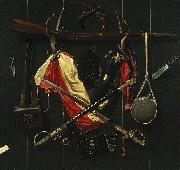 |
Alexander Pope
|
|
(21 May 1688 - 30 May 1744) was an eighteenth-century English poet, best known for his satirical verse and for his translation of Homer. He is the third most frequently quoted writer in The Oxford Dictionary of Quotations, after Shakespeare and Tennyson. Pope is famous for his use of the heroic couplet.
Pope was born to Edith Pope (1643-1733) and Alexander Pope Senior. (1646-1717) a linen merchant of Plough Court, Lombard Street, London, who were both Catholics. Pope's education was affected by the penal law in force at the time upholding the status of the established Church of England, which banned Catholics from teaching, attending a university, voting, or holding public office on pain of perpetual imprisonment. Pope was taught to read by his aunt, then went to Twyford School in about 1698-9. He then went to two Catholic schools in London. Such schools, while illegal, were tolerated in some areas.
In 1700, his family moved to a small estate at Popeswood in Binfield, Berkshire, close to the royal Windsor Forest. This was due to strong anti-Catholic sentiment and a statute preventing Catholics from living within 10 miles (16 km) of either London or Westminster. Pope would later describe the countryside around the house in his poem Windsor Forest. Pope's formal education ended at this time, and from then on he mostly educated himself by reading the works of classical writers such as the satirists Horace and Juvenal, the epic poets Homer and Virgil, as well as English authors such as Geoffrey Chaucer, William Shakespeare and John Dryden. He also studied many languages and read works by English, French, Italian, Latin, and Greek poets. After five years of study, Pope came into contact with figures from the London literary society such as William Wycherley, William Congreve, Samuel Garth, William Trumbull, and William Walsh.
At Binfield, he also began to make many important friends. One of them, John Caryll (the future dedicatee of The Rape of the Lock), was twenty years older than the poet and had made many acquaintances in the London literary world. He introduced the young Pope to the aging playwright William Wycherley and to William Walsh, a minor poet, who helped Pope revise his first major work, The Pastorals. He also met the Blount sisters, Teresa and (his alleged future lover) Martha, both of whom would remain lifelong friends.
From the age of 12, he suffered numerous health problems, such as Pott's disease (a form of tuberculosis that affects the bone) which deformed his body and stunted his growth, leaving him with a severe hunchback. His tuberculosis infection caused other health problems including respiratory difficulties, high fevers, inflamed eyes, and abdominal pain. He never grew beyond 1.37 m (4 ft 6 in) tall. Pope was already removed from society because he was Catholic; his poor health only alienated him further. Although he never married, he had many female friends to whom he wrote witty letters. He did have one alleged lover, |
|
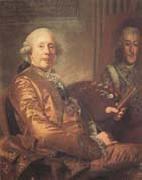 |
Alexander Roslin
|
|
1718--93
Swedish painter and pastellist, active in Germany and France. He trained with Lars Ehrenbill (1697-1747), a draughtsman employed by the Admiralty in Malmö, and in Stockholm under Georg Engelhardt Schräder (1684-1750), a portrait painter working in the tradition of Hyacinthe Rigaud and Nicolas de Largillierre. In 1741 Roslin moved to Göteborg, but the following year he returned to Malmö, where he executed devotional works for the parish church of Hasslöv, Halland, and began establishing himself as a portrait painter. |
|
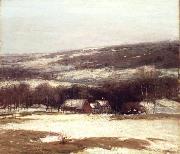 |
Alexander Theobald Van Laer
|
|
Alexander Theobald Van Laer (1857-1920) was an American painter, born at Auburn, New York.
He studied at the Art Students League of New York |
|
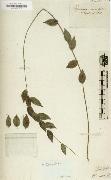 |
Alexander von Humboldt
|
|
Berlin 1769-1859 Berlin,was a German naturalist and explorer, and the younger brother of the Prussian minister, philosopher, and linguist Wilhelm von Humboldt (1767-1835). Humboldt's quantitative work on botanical geography was foundational to the field of biogeography. Between 1799 and 1804, Humboldt travelled to Latin America, exploring and describing it from a scientific point of view for the first time. His description of the journey was written up and published in an enormous set of volumes over 21 years. He was one of the first to propose that the lands bordering the Atlantic were once joined (South America and Africa in particular). Later, his five-volume work Kosmos (1845) attempted to unify the various branches of scientific knowledge. |
|
|
|
|
|
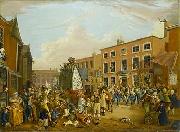 |
Alexander Wilson
|
|
Alexander Wilson (July 6, 1766 - August 23, 1813) was a Scottish-American poet, ornithologist, naturalist, and illustrator.
Wilson was born in Paisley, Scotland, the son of an illiterate distiller. In 1779 he was apprenticed as a weaver. His main interest at this time was in writing poetry (Robert Burns was seven years older than Wilson). Some of Wilson's work - commenting on the unfair treatment of the weavers by their employers - got him into trouble with the authorities. The "golden age of Renfrewshire song" is embodied in the persons of Wilson and Robert Tannahill. Alexander Wilson was born near the Hammils, a broad if not steep waterfall in Paisley where the River Cart skirts Seedhill. It does indeed appear to be the case, as William Motherwell states, that a great amount of literary activity began in Paisley around this time.
Illustration from
"An American ornithologyIn May 1794 Wilson left Scotland with his nephew to find a better life in America. Wilson obtained employment as a schoolteacher in Milestown, near Philadelphia. In 1801 he left Milestown and found a new teaching post in Gray's Ferry, Pennsylvania; Wilson took up residence in nearby Kingsessing. It was here that he met the famous naturalist William Bartram who developed Wilson's interest in ornithology. In 1802 Wilson decided to publish a book illustrating all the North American birds. With this in mind he traveled widely, watching and painting birds and collecting subscribers for his book. The result was the nine-volume American Ornithology (1808-1814), illustrating 268 species of birds, 26 of which had not previously been described. He died during the writing of the ninth volume, which was completed and published after his death by his friend George Ord. Wilson lies buried next to Ord at Gloria Dei Church cemetery in Philadelphia, Pennsylvania. |
|
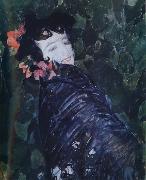 |
Alexander Yakovlevich GOLOVIN
|
|
an important Russian artist and stage designer who designed sets for many productions by Sergei Diaghilev,1863-1930 |
|
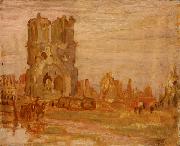 |
Alexander Young Jackson
|
|
(October 3, 1882 - April 5, 1974) was a Canadian painter and a founding member of the Group of Seven.
As a young boy, Jackson worked as an office boy for a lithograph company, after his father abandoned his family of six children. It was at this company that Jackson began his art training. In the evenings, he took classes at Montreal's Monument-National
In 1905, Jackson worked his way to Europe on a cattle boat, returning by the same means and travelling on to Chicago. In Chicago, he joined a commercial art firm and took courses at the Art Institute of Chicago. He saved his earnings and, by 1907, was able to visit France to study Impressionism. In France, Jackson decided to become a professional painter, studying at Paris' Academie Julian under J.P. Laurens.
|
|
|
|
|
|
 |
Alexandre Cabanel
|
|
1823-1889
French Alexandre Cabanel Locations
French painter and teacher. His skill in drawing was apparently evident by the age of 11. His father could not afford his training, but in 1839 his departement gave him a grant to go to Paris. This enabled him to register at the Ecole des Beaux-Arts the following October as a pupil of Francois-Edouard Picot. At his first Salon in 1843 he presented Agony in the Garden (Valenciennes, Mus. B.-A.) and won second place in the Prix de Rome competition (after Lon Benouville, also a pupil of Picot) in 1845 with Christ at the Praetorium (Paris, Ecole N. Sup. B.-A.). Both Cabanel and Benouville were able to go to Rome, as there was a vacancy from the previous year. Cabanel Death of Moses (untraced), an academic composition, painted to comply with the regulations of the Ecole de Rome, was exhibited at the Salon of 1852. The pictures he painted for Alfred Bruyas, his chief patron at this time (and, like Cabanel, a native of Montpellier), showed more clearly the direction his art had taken during his stay in Italy. Albayde, Angel of the Evening, Chiarruccia and Velleda (all in Montpellier, Mus. Fabre) were the first of many mysterious or tragic heroines painted by Cabanel and show his taste for the elegiac types and suave finish of the Florentine Mannerists. |
|
 |
Alexandre Cabanel
|
|
French Academic Painter, 1823-1889
French painter and teacher. His skill in drawing was apparently evident by the age of 11. His father could not afford his training, but in 1839 his departement gave him a grant to go to Paris. This enabled him to register at the Ecole des Beaux-Arts the following October as a pupil of Franeois-Edouard Picot. At his first Salon in 1843 he presented Agony in the Garden (Valenciennes, Mus. B.-A.) and won second place in the Prix de Rome competition (after Leon B?nouville, also a pupil of Picot) in 1845 with Christ at the Praetorium (Paris, Ecole N. Sup. B.-A.). Both Cabanel and Benouville were able to go to Rome, as there was a vacancy from the previous year. Cabanel's Death of Moses (untraced), an academic composition, painted to comply with the regulations of the Ecole de Rome, was exhibited at the Salon of 1852. |
|
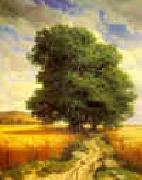 |
Alexandre Calame
|
|
1810-1864
French Alexandre Calame Locations
Swiss painter, draughtsman and printmaker. He studied under Francois Diday in Geneva and then travelled to Paris (1837), to the Netherlands and Desseldorf (1838), to Italy (1844) and to London (1850). Despite his frail health he spent each summer painting in the mountains of the Bernese Oberland and central Switzerland, where he produced the drawings and studies from nature that were later used in his studio compositions. A fervent Calvinist, he saw his subjects. |
|
|
|
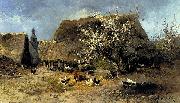 |
Alexandre Defaux
|
|
(1826-1900) was a French artist. He was born in Bercy and studied under Jean-Baptiste Camille Corot. He was a member of the Barbizon School.
|
|
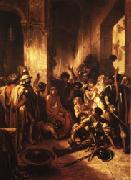 |
Alexandre Gabriel Decamps
|
|
French Romantic Painter, 1803-1860.
Studied under Abel de Pujol.
Specializes in Orientalism.
Studied under Abel de Pujol. Specializes in Orientalism. French genre and historical painter, engraver, and lithographer. First known for his caricatures and illustrations, he turned to painting in thick impasto and strong color. One of his richest sources was the Middle East, which he depicted in vivid detail. |
|
|
|
|
|
|
|
|
|
|
|
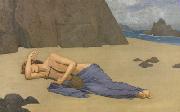 |
Alexandre Seon
|
|
French Symbolist Painter, 1855-1917
was a French Symbolist artist, illustrator and decorator. Seon studied at the Beaux-Arts of Lyon and Paris, becoming a student of Puvis de Chavannes in 1891, with whom he later collaborated. He was closely associated with Josephin Peladan and his Salon de la Rose-Croix, and designed the frontispiece for Peladan's 1891 novel l'Androgyne |
|
|
|
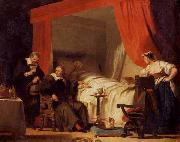 |
Alexandre-Evariste Fragonard
|
|
French Painter, 1780-1850,son of Jean-Honore Fragonard, was a French painter and sculptor in the troubadour style. He received his first training from his father and drew from him his piquant subjects and great facility, perfecting them under David. |
|
|
|
Alexandre-Francois Caminade
|
|
Alexandre-Francois Caminade (December 14, 1783 - May 1862) was a French painter.
Caminade was born and died in Paris. He was a portraitist and a religious painter. He was Jacques Louis David's pupil. See also, Larousse article at Cyclopedia of Painters and Paintings, eds. John Desnison Champlin and Charles Callahan Perkins |
|
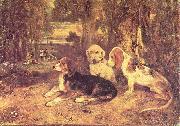 |
Alexandre-Gabriel Decamps
|
|
(March 3, 1803 - August 22, 1860) was a French painter.
He was born in Paris. In his youth he travelled in the East, and reproduced Oriental life and scenery with a bold fidelity to nature that puzzled conventional critics. His powers, however, soon came to be recognized, and he was ranked along with Delacroix and Vernet as one of the leaders of the French school. At the Paris Exhibition of 1855 he received the grand or council medal. Most of his life was passed in the neighborhood of Paris. He was fond of animals, especially dogs, and indulged in all kinds of field sports. He died in 1860 in consequence of being thrown from a horse while hunting at Fontainebleau.
Decamps' style was characteristically and intensely French. It was marked by vivid dramatic conception, bold and even rough brushstrokes, and startling contrasts of color and of light and shade. His subjects embraced an unusually wide range. He availed himself of his travels in the East in dealing with scenes from Scripture history, which he was probably the first of European painters to represent with their true and natural local background. Of this class were his Joseph sold by his Brethren, Moses taken from the Nile, and his scenes from the life of Samson, nine vigorous sketches in charcoal and white.
Perhaps the most impressive of his historical pictures is Defeat of the Cimbri, representing the conflict between a horde of barbarians and a disciplined army. Decamps produced a number of genre pictures, chiefly scenes from French and Algerian domestic life, the most marked feature of which is humour. The same characteristic attaches to many of his numerous animal paintings; Decamps was especially fond of painting monkeys. His well-known painting The Monkey Connoisseurs satirizes the jury of the French Academy of Painting, which had rejected several of his earlier works on account of their divergence from any known standard. |
|
|
|
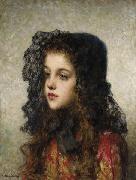 |
Alexei Harlamov
|
|
(or Alexej Harlamoff - Alexej Charlamoff) (1840-1925) was a Russian painter.
Harlamoff paintings are signed "Harlamoff", which may be a translation he learned while studying in Paris. This does not translate into the Russian language from English. |
|
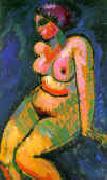 |
Alexei Jawlensky
|
|
1864-1941
Russian
Alexei Jawlensky Galleries
Alexej von Jawlensky was born in Torzhok, a town in the department of Tver, Russia, as the fifth child of Georgi von Jawlensky and his wife Alexandra (n??e Medwedewa). His family was aristocratic.
At the age of ten he moved with his family to Moscow. After a few years of military training, he became interested in painting, visiting the Moscow World Exposition c. in 1880.
In 1896 he moved to Munich where he studied in the private school of Anton Azbe. In Munich he met Wassily Kandinsky, and Marianne von Werefkin, other Russian artists and helped form the Neue Kunstlervereinigung M??nchen. His work in this period was lush and richly coloured, but later moved towards abstraction with a simplified and formulaic style in a search to find the spiritual.
Alexej von Jawlensky. Abstract Head, c. 1928He died in Wiesbaden, Germany on 15 March 1941. |
|
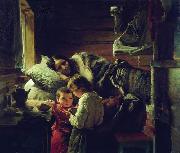 |
Alexei Korzukhin
|
|
(1835-1894) was Russian painter. A Korzukhin 000.JPG
Korzukhin was born in Yekaterinburg on March 23, 1835. In 1858 he began his studies in the St. Petersburg in the Imperial Academy of Arts. In 1860, Korzukhin won his first award for the painting his The Drunken Father.
In 1864, he help found Petersburg Artel of Artists - the "Revolt of Fourteen". Korzukhin has received a rank of the artist of the First Degree for his painting Commemoration on a Rural Cemetery (1865). For The Return of the Father from Fair, he received a rank of the academician. In 1870, he became a founding member of the art group 'The Wanderers.
In 1891 he painted The Lord's Supper for a cathedral in Riga. Korzukhin is perhaps most famous for his many portraits, each of which is characterized to have a subtle psychological depth. For this reason they are generally accepted as masterpieces of Russian portrait painting.
Alexei Korzukhin died in St. Petersburg on October 30, 1894.
|
|
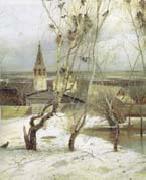 |
Alexei Savrasov
|
|
Russian Painter, 1830-1897
was a Russian landscape painter and creator of the lyrical landscape style. Savrasov was born into the family of a merchant. He began to draw early and in 1838 he enrolled as a student of professor Rabus at the Moscow School of Painting, Sculpture and Architecture (graduated in 1850), and immediately began to specialize in landscape painting. In 1852, he traveled to Ukraine. Then, in 1854 by the invitation of the Grand Duchess Maria Nikolayevna, President of the Imperial Academy of Arts, he moved to the neighborhood of St. Petersburg. In 1857, Savrasov became a teacher at the Moscow School of painting, sculpturing and architecture. His best disciples, Isaac Levitan and Konstantin Korovin, remembered their teacher with admiration and gratitude. The Rooks Have Come Back was painted by Savrasov near Ipatiev Monastery in Kostroma.In 1857, he married Sophia Karlovna Hertz, sister of art historian K. Hertz. In their home they entertained artistic people and collectors including Pavel Tretyakov. Savrasov became especially close with Vasily Perov. Perov helped him paint the figures of the boat trackers in Savrasov's Volga near Yuryevets, Savrasov painted landscapes for Perov's Bird catcher and Hunters on Bivouac. In the 1860s, he traveled to England to see the International Exhibition, and to Switzerland. In one of his letters he wrote that no academies in the world could so advance an artist as the present world exhibition. The painters who influenced him most were British painter John Constable and Swiss painter Alexandre Calame. The Rooks Have Come Back (1871) is considered by many critics to be the high point in Savrasoves artistic career. Using a common, even trivial, episode of birds returning home, and an extremely simple landscape, Savrasov emotionally showed the transition of nature from winter to spring. It was a new type of lyrical landscape painting, called later by critics the mood landscape. The painting brought him fame. In 1870, he became a member of the Peredvizhniki group, breaking with government-sponsored academic art. In 1871, |
|
|
|
|
|
|

